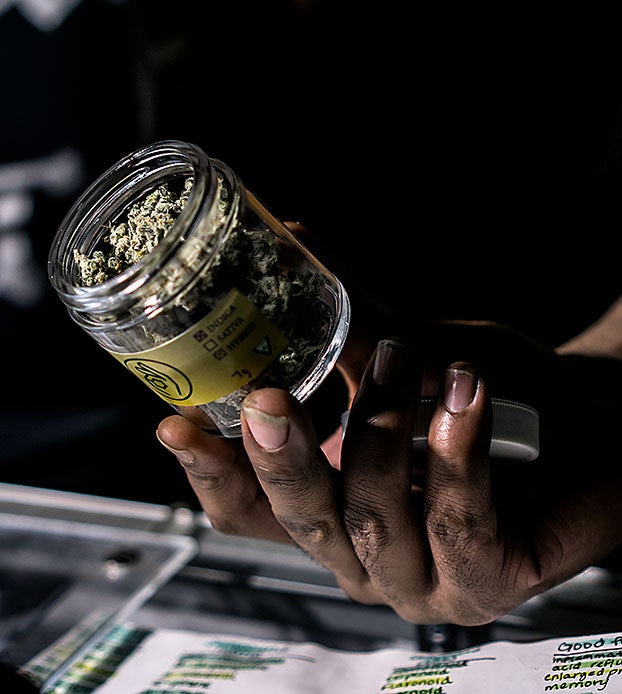So you’re wondering what type of marijuana is best for multiple sclerosis. As is often the case with marijuana — there’s no simple answer. However, by looking at the cannabinoids and terpenes that show promise for multiple sclerosis, you can make educated decisions and effectively narrow down your options.
Once you’ve covered the basics about marijuana and multiple sclerosis, take a look at the rcight way to choose and use marijuana strains and products. Generally, cannabis can help with three main issues of MS — sleep problems, pain and spasticity. When picking a strain, it’s important to know what symptom/s you need to treat, as different cannabinoids and terpenes could be more efficient for each.
Types of cannabis
Marijuana strains, or more accurately, chemotypes (chemical types) can be divided to three groups:
- Type I: High THC, low CBD
- Type II: Balanced (roughly 1:1) THC-CBD ratio
- Type III: High CBD, low THC
Type I is often the go-to for recreational consumers, but since CBD can alleviate some of the adverse effects of THC, and make dosing THC easier, Types II and III are often recommended by physicians and sought after by patients. These chemovars could also help mitigate the biphasic effect of THC, where low doses could help treat anxiety, for instance, and higher doses could actually trigger these effects.
How to choose a strain for multiple sclerosis
After you decide on the type of cannabis that’s best for you, two of the main factors to consider are the symptoms you want to treat, as each symptom may benefit from different cannabinoids and terpenes that are more likely to treat them.
In a 2019 study, some 400 MS patients used medical marijuana to ease their symptoms. The majority (70%) of patients reported benefitting from cannabis for pain relief, 56% found that it helped with sleep disturbances like insomnia, and 49% said it helped with spasticity. So, looking for marijuana strains that could help with each of these symptoms — together or separately — would make sense.
The entourage effect theory suggests a synergy between cannabinoids and terpenes in order to maximize effects. This theory is mostly based on preliminary research, so it’s not yet accepted as a “scientific truth,” and more research is needed. But it does make sense, and given the dearth of evidence-based ways to match chemotypes with symptoms and conditions, for now the entourage effects theory is the best bet when trying to find the right cannabis for you.
- Chemovars for pain management include THC and CBD, along with terpenes myrcene, linalool, beta-caryophyllene, humulene and limonene.
- Chemovars for sleep include THC and CBN, and terpenes beta-caryophyllene (BCP), myrcene and linalool. CBN is a minor cannabinoid, so if present, it’s often found in lower percentages as compared to THC and CBD.
- Chemovars for muscle relaxation include THC, and terpenes myrcene and limonene.
When considering day strains vs. night strains, keep in mind that myrcene, BCP and linalool are often thought to be more sedative, while limonene, pinene and terpinolene could have a more energizing effect. Though as mentioned, the scientific evidence on the topic isn’t conclusive.
Marijuana products often have one dominant terpene with concentrations above 1% and a few more with lower concentrations between 0.1 and 1%, or a few (often two to five) terpenes in modest concentrations of 0.1% to 1%. Nevertheless, terpenes are considered as being of pharmacological interest at concentrations above 0.05%, so you can expect much lower numbers compared to the concentrations of THC or CBD.
But at the end of the day, strain names can take you only so far. You can expect an estimation of the type of chemical profile you’ll encounter, but not much more. No one ever defined the chemical makeup of Strawberry Cough or Grand Daddy Purple. There’s no definition or trademark for strain names — anyone can grow anything and call as they wish.
Best strains for multiple sclerosis
The Cannigma strain reviews are based on average numbers from test results of products that have a similar name. But what’s really going to affect your experience is the ingredients in the one you get.
The following list can help you narrow down the options, but keep in mind you could also find the below products with different chemical profiles, so it’s important to know which chemicals are more likely to work for the symptoms you’re trying to treat. It’s also important to note that the numbers below reflect on tests of dried cannabis, as opposed to extracted cannabis products.
Here’s a list of marijuana strains (chemovars) that we identified as likely to be beneficial for pain sleep and spasticity. Keep in mind that some of the strains that can help with sleep could also be good for spasticity or pain, and vice versa.
Strains for pain
- Amnesia
A Type I strain with an average of 18% THC, high in beta-caryophyllene and humulene, this combination of pain relieving terpenes and high THC could be particularly effective for daytime pain.
- Canna-Tsu
A child of Cannatonic and Harle-Tsu, this Type III strain is often high in CBD (7%), low in THC (2%), and high in myrcene and BCP. A better choice if you’re new to cannabis, have a low tolerance to THC or just prefer a lighter high.
- Pennywise
A nicely-balanced Type II strain (9.3% CBD and 9.7% THC), Pennywise can be high in myrcene, beta-caryophyllene and pinene.
- ACDC
With around 11% CBD and 1.5% THC, this Type III chemovar is dominant in myrcene, BCP and limonene, all of which are suggested as pain relievers.
Strains for sleep
- Cinderella 99
Slightly less potent than Amnesia, C99 averages at 15% THC, and is linalool dominant with some humulene and beta-caryophyllene — yet another nice combination for a good night of painless sleep. Keep in mind that if the Cinderella 99 product is higher in pinene, it may be better suited for daytime use and not for sleep.
- Forbidden Fruit
Straight from heaven, Forbidden Fruit is a Type I strain that often has high myrcene, beta-caryophyllene and linalool. But sometimes it also tests with high levels of the energizing limonene, so make sure it’s not limonene dominant when you pick your product.
- Critical Mass
With moderate levels of both THC and CBD, and varying amounts of beta-caryophyllene, myrcene, and humulene- this strain could be a good choice for night-time pain management.
Strains for spasticity
- Skywalker OG
A potent (20% THC) Type I strain, Skywalker OG is also often dominant in limonene and myrcene. Like THC, both these terpenes are thought to be muscle relaxants. High limonene chemotypes are a good bet for daytime and high myrcene chemovars for nighttime.
- SVF OG
Slightly less potent than Skywalker OG (17% THC), SVF is also a Type I strain with a very similar terpene profile (high limonene and myrcene).
- Ringo’s Gift
A Type III chemovar, Ringo’s Gift is often very low in THC (average 0.7%), and high in myrcene, with trace amounts of pinene, beta-caryophyllene and limonene. This is a good option if you’re new to cannabis, or have a low THC tolerance. But keep in mind that you’ll want to look for a Ringo’s Gift chemovar that is high in myrcene or limonene and has some amount of THC (preferably around 1%).
Sign up for bi-weekly updates, packed full of cannabis education, recipes, and tips. Your inbox will love it.

 Shop
Shop Support
Support
















